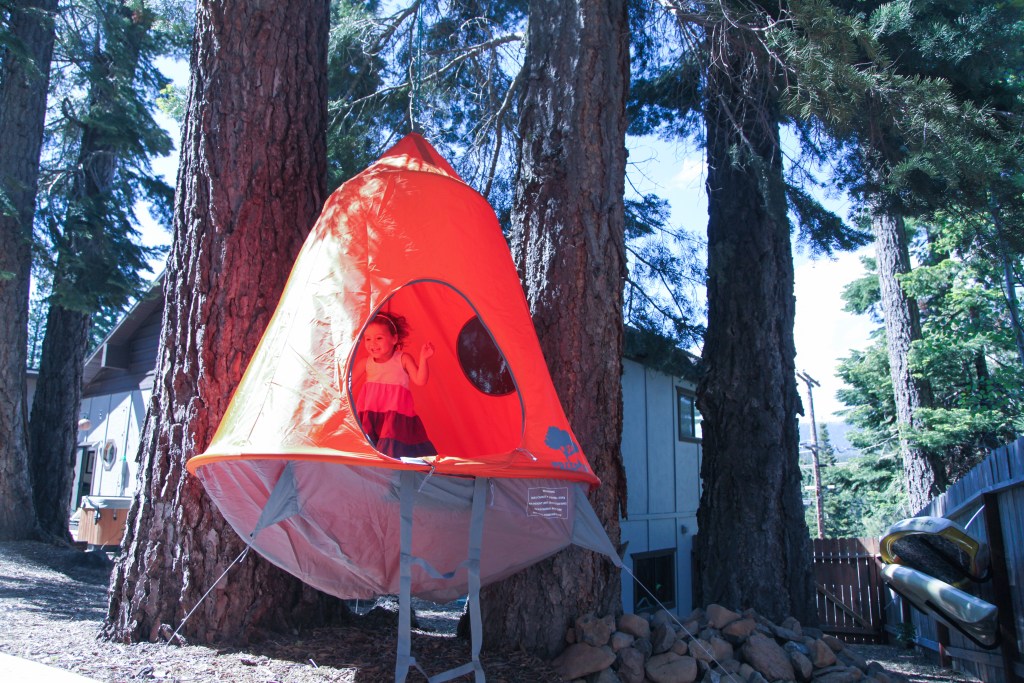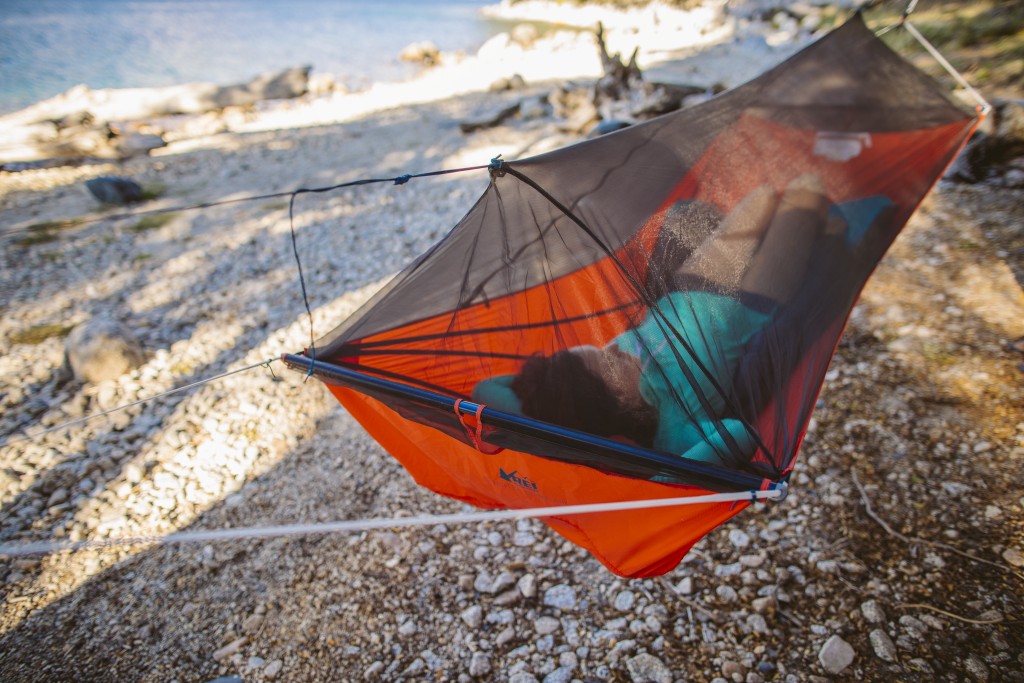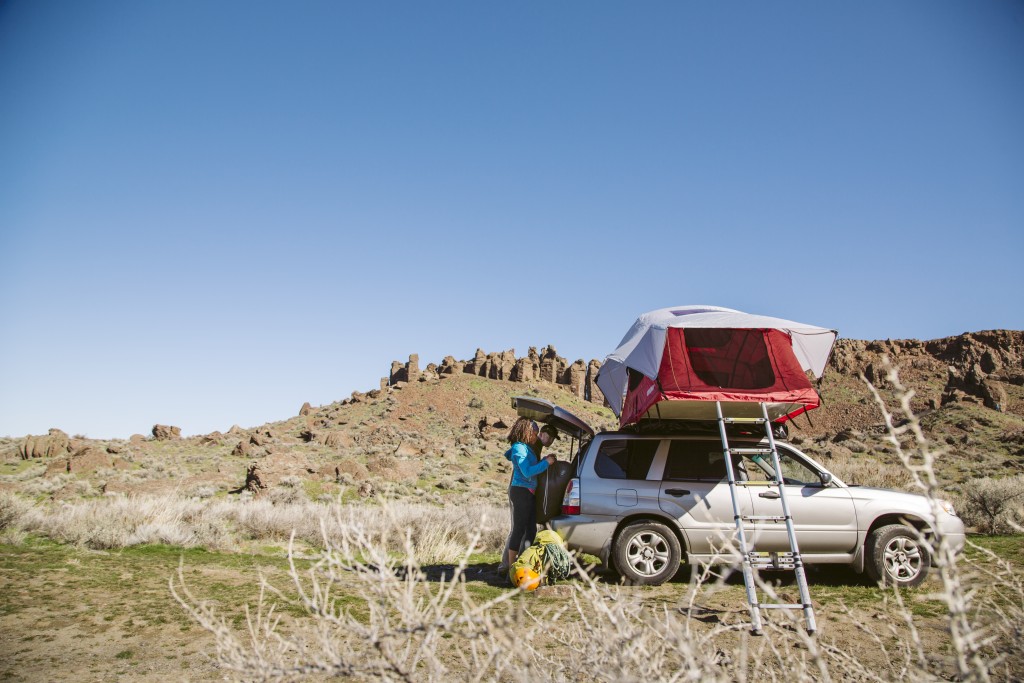Above-the-ground tents—treehouse tents, rooftop tents and tricked-out hammocks—may be camping’s latest trend, but they’re also more practical than you think.
My daughter, Nora, spotted the treehouse from across the field. We were camping on California’s Sonoma Coast and the treehouse, a weathered wooden platform about the size of a two-person tent, sat perched in a giant oak not far from our campsite. “Treehouse!” she exclaimed, as she sprinted toward it. Within minutes, my rambunctious almost-3-year-old was climbing the rickety wooden ladder as I watched nervously from below. From the top of her new tree-dwelling castle, she announced, “I want a treehouse.”

So, a week later, my husband strung a rope between two pine trees in our backyard, then attached a bright orange, kid-sized tent that hovered a couple of feet off the ground. Instant treehouse. No hammer and nails. No splintering wood. No shaky ladders. Nora loved it, and she now spends a good stretch of each day bouncing, reading, snacking and lounging in her new fortress. Once, I thought she might even take a nap in there.
What is this mysterious treehouse that pops up in minutes? It’s called a TreePod, a small, teardrop-shaped tent made from sturdy, water-resistant nylon that hangs from a strong tree branch. It has a zip-up doorway to create a cocoon-like effect and two mesh-lined windows for peeking out at the world. It costs $300 and can be assembled in less than 30 minutes.
The TreePod is just one example of a new and growing market of so-called suspension tents—hanging, above-the-ground shelters like hammocks, car-rooftop-tents and tree tents. The coolest part? Campers around the country are discovering that these airborne tents aren’t just for novelty or fun. They also have a genuine purpose and surprising benefits over standard, down-in-the-dirt tents.
These creative, pop-up tents are more than just fun-looking—they also solve common camping dilemmas.
The TreePod is the invention of a guy named Ricardo Bottome, who has four daughters and wanted to find an easier to way to give his kids a backyard treehouse. He launched TreePod via Kickstarter in late 2015. The idea has taken off: His company has doubled its sales in the last year and a half.
Bottome’s initial idea was to create a play structure, not so much a camping tent, but as soon as TreePod launched he started getting feedback from customers who asked, “When are you going to make a hanging tent big enough for adults to sleep in?”
So in spring 2018, TreePod will debut its first TreePod Camper, which will sleep two adults in a tent that hangs from a tree or attaches to a car hitch.
“This elevates your camping,” Bottome said. “It gives you a level surface to sleep on, so you don’t have to worry about water, rocks, bugs or uneven surfaces.”

These creative, pop-up tents are more than just fun-looking—they also solve more than one camping dilemma. Take Tentsile’s Stingray, a spider-web-like treehouse tent that was designed by a British architect. You may want this tent on your next camping trip if you’re going to a place known for decent-sized trees and terrain that’s marshy or good snake or tick habitat. That way, you don’t have to worry about finding the perfect place to pitch your tent—just pick three sturdy well-spaced trees and you’re set for the night.

Or there’s the REI Co-op Quarter Dome Air Hammock, a durable one-person hammock with built-in insect mesh and a rainfly that strings between two trees. It’s light enough for backpacking and ideal for camping in a place that’s damp, rocky or critter-infested.

Heading to the desert or someplace without giant trees? No problem. Check out the expanding market of innovative rooftop tents that snap open on top of your truck or car. The Yakima SkyRise 3 rooftop tent is a spacious, easy-to-assemble three-person tent that you access via a ladder. With this, you only need a simple parking space to set up a well-appointed campsite. If you need more room, the Tepui Autana XL Sky 4 tent has a car-rooftop sleeping area plus an on-the-ground living area—perfect for families.
These tents are gaining in popularity and redefining the way people camp because they’re quick to pop up, have less cumbersome tent poles and avoid the pest factor. “A lot of people like to be away from the critters,” Bottome added.
As for my daughter, she loves bugs. But she also loves having her own private space—whether we’re camping or just playing in the backyard—and an elevated view of the world.
